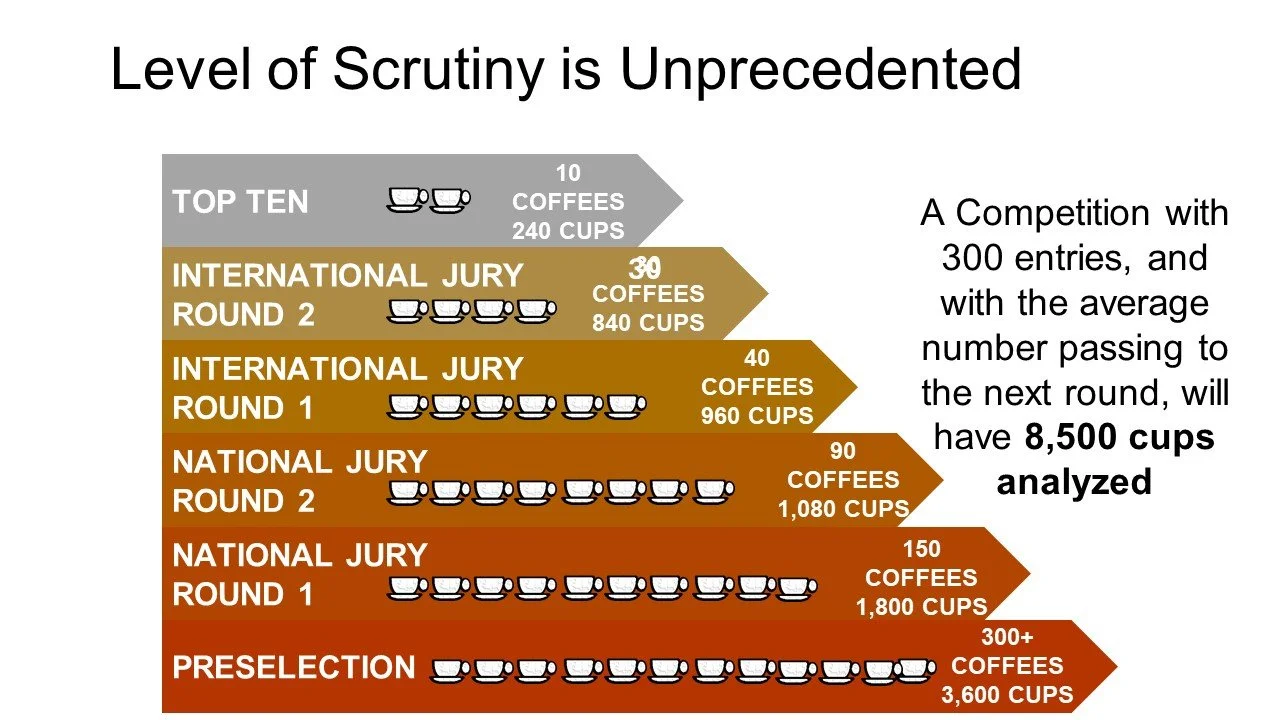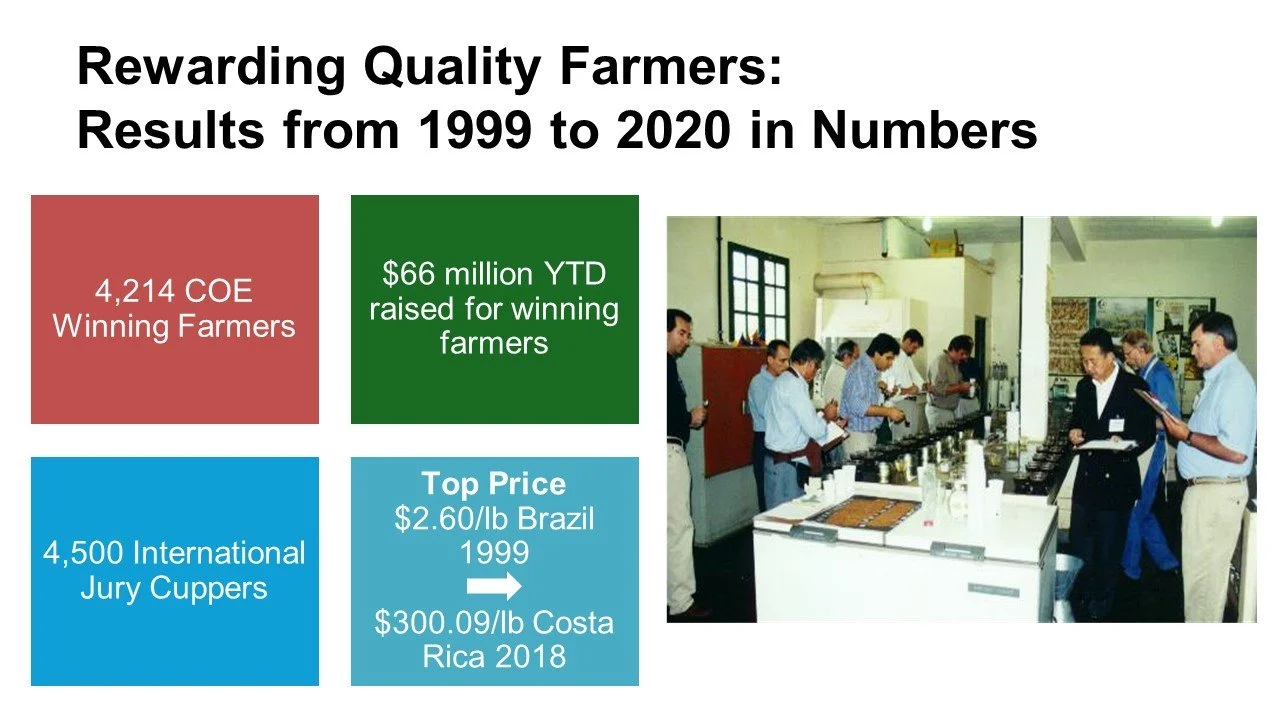A Deep Dive into Cup of Excellence
My sincere thanks to Peter Jones of Idle Hands Roasting and Trident Cafe, and to Benjamin Paz of Beneficio San Vicente, for their help with this post. If you enjoy this post and want to help increase awareness of Cup of Excellence, please share this post. Thank you.
Cup of Excellence is a competition of coffee quality held annually in numerous producing countries. Each competition involves six rounds of evaluation, a national jury, and an international jury. Cup of Excellence was founded by George Howell, Susie Spindler, and Silvio Leite in 1999. The first competition was held in Brazil, and the program has since expanded to sixteen producing countries.
Why I love Cup of Excellence
I love Cup of Excellence for many reasons: the competition promotes improved coffee quality, winners (those who qualify for the auction) receive very large price premiums for their coffees, COE incentivizes investment in quality, it connects buyers and sellers, and it rewards fantastic work. COE also does a lot to validate and recognize coffee quality in a way that helps grow the market for premium specialty coffee. We support COE at Prodigal because it is one of the few initiatives I’m aware of that fosters many unambiguous, positive outcomes for everyone involved. In the words of my friend Peter Jones, who has judged numerous COE competitions, “winning changes people’s lives.”
They’re not messing around
Years ago, I thought COE was simply a competition involving high-quality coffee. I drastically underestimated the depth, complexity, and impact of the competition: by the time the competition is over, approximately 8700+ cups will have been tasted and scored by the judges, volunteers will have given thousands of hours of their time to the competition, and the competition will have changed many lives.
A tremendous amount of effort goes into making each COE competition a success. About 40 volunteers each spend a week or two working hard to make a competition run smoothly. The national jury gives several days of their time to cup and score hundreds of coffees several times each. The international jury pay for their own flights and volunteer a week of their lives to each competition. Entire families, and often many neighbors from a producer’s community, will travel to the event to support a producer whose coffee is in the competition.
COE is open to all farmers in a given country. Each farmer may enter one sample at no cost. All coffees are cupped “blindly”, meaning judges do not know the name of the farmer, the farm, or the varieties of the coffees on the table. To qualify and advance in the competition, a sample must score at least 86 points.
slides courtesy of Scott Conary of Carrboro Coffee Roasters
Judging
The national jury is made up of experienced cuppers from the country of origin. This jury cups all of the coffees entered at pre-selection, and samples that score 86 or higher advance to the national jury week. After the national jury whittles the number of qualifying coffees down to 40, the judging is passed on to the international jury.
The international jury is made up of cuppers from both producing and consuming countries. Each judging panel spends one full day doing extensive calibration. To become a member of an international jury, a judge must take a standardized sensory training, participate in COE as an “observer” judge, and successfully calibrate his or her scores with those of experienced judges.
National Jury Day One (Calibration)
Before the competition begins, an in-country organization, such as the producing country’s SCA chapter, collects the samples entered into the competition. The head judge flies in and selects the national jury of 20 judges. The head judge spends a full day calibrating the national jury. On calibration day, the judges cup three tables of 10 coffees, with each coffee duplicated on the other side of the table. This process is repeated twice. Judges are expected to be consistent in how they score the duplicate cups, and to show a dynamic range in their scores, especially for a few outlier (non-competition) coffees added to the calibration tables.
National Jury Day Two (pre-selection)
On day one of the competition, the judges cup each sample four times, with typically 300 or more samples submitted to the competition. Cups must score an average of 86 points or higher to advance in the competition, with a maximum of 150 samples moving on to the next round.
After samples have passed round one, the producers must move their entire lots to a bonded warehouse overseen by an independent auditor. Samples cupped in successive rounds are drawn from these lots.
National Jury Day Three
The national jury cups the samples that passed the pre-selection round. A maximum of 90 samples advance to round three. Samples must again score 86 or higher to reach the next round.
National Jury Day Four
Judges cup the samples, choosing a maximum of 40 samples to advance to the international jury.
International Jury Day One:
All-day calibration
International Jury Day Two & Three
The international jury cups the samples and decides which will be awarded the “Cup of Excellence” label. Those 30 lots will enter the auction, and the scores for places 11—30 are now finalized.
International Jury Day Four
On the final day of the international jury, the judges re-cup the ten highest-scoring samples to give them extra scrutiny and finalize their scores and ranking. This day is fun for the judges, as the hard work of intense cupping is behind them, and they get to enjoy cupping ten beautiful coffees at a relaxed pace. Peter Jones told me there is a nice tradition of the international judges tipping the volunteers at the end of the competition.
International Jury Day Five
Day five is the big reveal and party. Paraphrasing Peter: “it’s emotional; government officials come, farmers and their families, and sometimes their neighbors, come, and all of the winners get a plaque and a certificate. Everyone is very supportive, cheering on farmers, and you can see and feel the emotions of everyone involved. Everyone goes crazy when they reach the top three, and people are crying and cheering. You can tell the farmers’ lives are changed by placing in the competition.”
The Auction
About five or six weeks after the competition, the top 30 lots are sold in an internet auction. Competition lots that scored above 85 but did not reach the top 30 qualify for the National Winners Auction.
COE Cupping form
Impact
A Technoserve report from 2015 of COE’s impact in Brazil and Honduras found impressive direct and indirect benefit to producing communities and concluded COE acted as a catalyst for specialty-coffee industry growth in participating countries. COE competitions have promoted direct trade, helped forge new relationships between buyers and producers, and promoted specialty coffee growth in new markets, especially in Asia.
According to the report “the premiums paid by COE are several times higher than prevailing specialty and direct trade prices. These high premiums encourage producers to enter a beneficial cycle of improved quality, greater recognition for specialty coffee, and greater demand….The indirect benefits from COE are estimated to be more than $100 million for Brazil and $22 million for Honduras (and are included in the total benefit cited above).”
Presumably, nine years later, the economic impact of COE in those countries is now far greater than it was at the time of the report.
A Producer’s Perspective.
I asked Benjamin Paz of Beneficio San Vicente to tell me a little about his experience with COE, and his perspective on the benefits of the competition. Benjamin began working with farmers in 2005-2006 to help them place well in COE. In 2011, Benjamin bought his own farm, and has placed many times in the COE competition. Benjamin’s coffee came in first place in 2022 and 2024!
Benjamin says participating in COE has generated a lot of interest in San Vicente, and Santa Barbara coffees in general, not just in the farms that have placed well in the competition. That may be the true virtue of COE: rewarding hard work by bringing attention to farmers and regions producing amazing coffee.
One example of COE focusing attention where it belongs happened in 2015. Benjamin cupped a new hybrid variety that wasn’t very popular at the time. He recommended the producer submit the coffee to COE, despite others saying it would not do well. That coffee, the first parainema to enter COE, came in first place :). Personally, I have loved the few parainemas I have tasted, and understand what Benjamin saw in that coffee.
Prodigal is a proud participant in Cup of Excellence
Because we greatly admire the Cup of Excellence program, we have already purchased lots in several recent COE auctions, and hope to purchase lots from many more in the future. This week we released two Ethiopian COE winners and lots on the way from the Best of Rwanda and other COE competitions.















